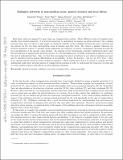Files in this item
Multiplex networks in metropolitan areas : generic features and local effects
Item metadata
| dc.contributor.author | Strano, Emanuele | |
| dc.contributor.author | Shai, Saray | |
| dc.contributor.author | Dobson, Simon Andrew | |
| dc.contributor.author | Barthélemy, Marc | |
| dc.date.accessioned | 2016-09-23T23:34:58Z | |
| dc.date.available | 2016-09-23T23:34:58Z | |
| dc.date.issued | 2015-10 | |
| dc.identifier | 213789297 | |
| dc.identifier | eec55310-0307-48a9-9a98-1efa3ba3f6a0 | |
| dc.identifier | 84945971791 | |
| dc.identifier | 000363487600019 | |
| dc.identifier.citation | Strano , E , Shai , S , Dobson , S A & Barthélemy , M 2015 , ' Multiplex networks in metropolitan areas : generic features and local effects ' , Journal of the Royal Society Interface , vol. 12 , no. 111 . https://doi.org/10.1098/rsif.2015.0651 | en |
| dc.identifier.issn | 1742-5689 | |
| dc.identifier.other | ORCID: /0000-0001-9633-2103/work/70234206 | |
| dc.identifier.uri | https://hdl.handle.net/10023/9544 | |
| dc.description | MB acknowledges funding from the European Commission FET-Proactive project PLEXMATH (Grant No. 317614). SS thanks the James S. McDonnell Foundation 21st Century Science Initiative - Complex Systems Scholar Award (grant 220020315) and the Scottish Informatics and Computer Science Alliance for financial support. | en |
| dc.description.abstract | Most large cities are spanned by more than one transportation system. These different modes of transport have usually been studied separately: it is however important to understand the impact on urban systems of the coupling between them and we report in this paper an empirical analysis of the coupling between the street network and the subway for the two large metropolitan areas of London and New York. We observe a similar behaviour for network quantities related to quickest paths suggesting the existence of generic mechanisms operating beyond the local peculiarities of the specific cities studied. An analysis of the betweenness centrality distribution shows that the introduction of underground networks operate as a decentralising force creating congestions in places located at the end of underground lines. Also, we find that increasing the speed of subways is not always beneficial and may lead to unwanted uneven spatial distributions of accessibility. In fact, for London – but not for New York – there is an optimal subway speed in terms of global congestion. These results show that it is crucial to consider the full, multimodal, multi-layer network aspects of transportation systems in order to understand the behaviour of cities and to avoid possible negative side-effects of urban planning decisions. | |
| dc.format.extent | 9 | |
| dc.format.extent | 2477251 | |
| dc.language.iso | eng | |
| dc.relation.ispartof | Journal of the Royal Society Interface | en |
| dc.subject | Complex networks | en |
| dc.subject | Urban networks | en |
| dc.subject | Transportation | en |
| dc.subject | Spatial networks | en |
| dc.subject | QA75 Electronic computers. Computer science | en |
| dc.subject | DAS | en |
| dc.subject | SDG 11 - Sustainable Cities and Communities | en |
| dc.subject.lcc | QA75 | en |
| dc.title | Multiplex networks in metropolitan areas : generic features and local effects | en |
| dc.type | Journal article | en |
| dc.contributor.institution | University of St Andrews. School of Computer Science | en |
| dc.identifier.doi | 10.1098/rsif.2015.0651 | |
| dc.description.status | Peer reviewed | en |
| dc.date.embargoedUntil | 2016-09-23 | |
| dc.identifier.url | http://rsif.royalsocietypublishing.org/content/12/111/20150651 | en |
This item appears in the following Collection(s)
Items in the St Andrews Research Repository are protected by copyright, with all rights reserved, unless otherwise indicated.

